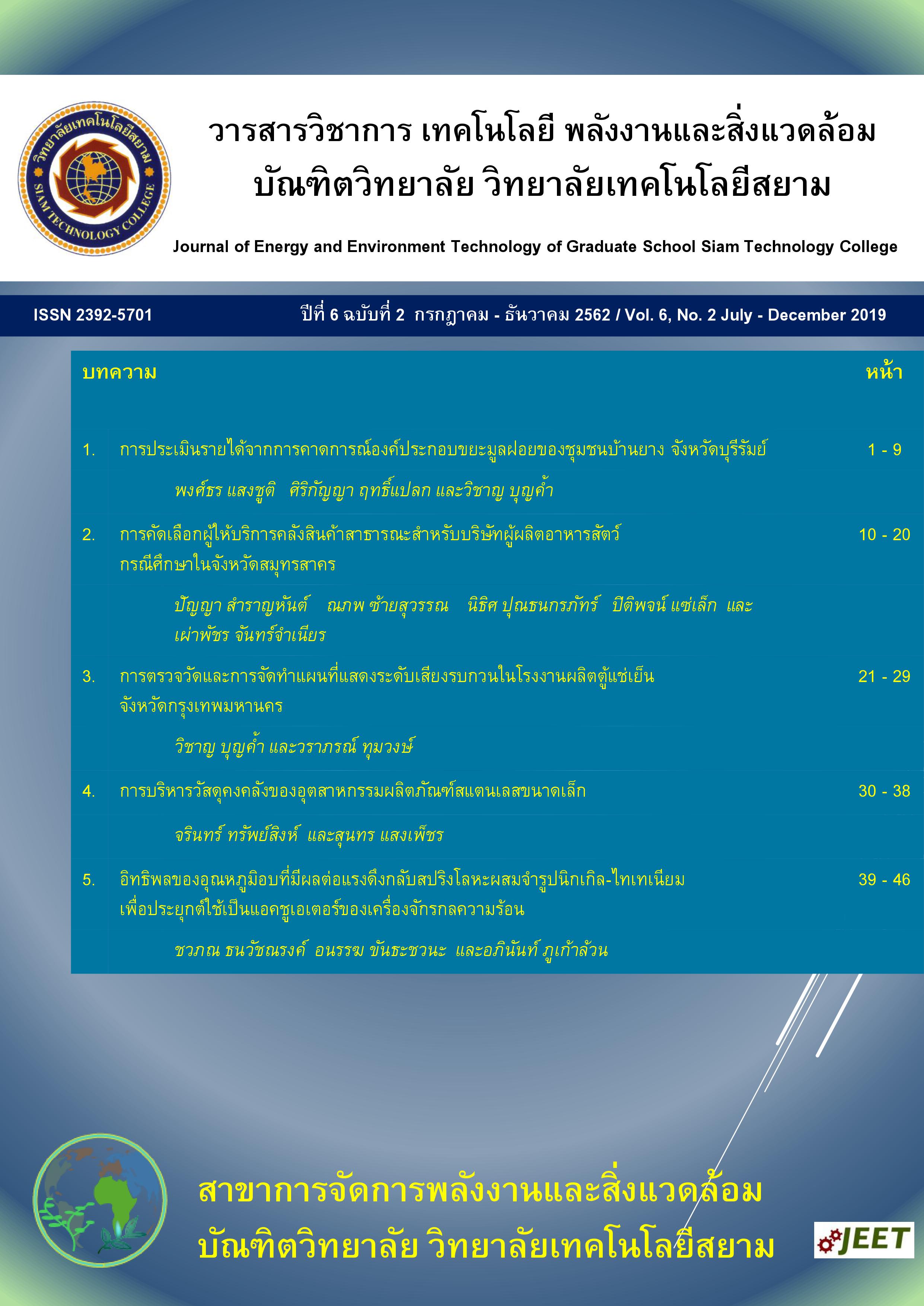อิทธิพลของอุณหภูมิอบที่มีผลต่อแรงดึงกลับของสปริงโลหะผสมจำรูปนิกเกิล-ไทเทเนียม เพื่อประยุกต์ใช้เป็นแอคชูเอเตอร์ของเครื่องจักรกลความร้อน
Main Article Content
บทคัดย่อ
เป็นที่ทราบกันดีว่าหากต้องการนำโลหะผสมจำรูปมาประยุกต์ใช้เป็นแอคชูเอเตอร์ จำเป็นต้องผ่านกรรมวิธีทางความร้อนเพื่อให้สามารถจำรูปตามที่ต้องการได้ กรรมวิธีทางความร้อนมีผลกระทบโดยตรงต่อสมบัติเชิงกลของโลหะผสมจำรูป งานวิจัยนี้จึงได้ศึกษาอิทธิพลของอุณหภูมิอบของสปริงโลหะผสมจำรูปนิกเกิล-ไทเทเนียม โดยใช้ลวดที่มีขนาดเส้นผ่านศูนย์กลาง 0.7 mm มาขึ้นรูปสปริงโดยกำหนดค่าดัชนีของสปริงเท่ากับ 6.71 และอบที่อุณหภูมิ 350, 400 และ 450oC จากนั้นทดสอบอุณหภูมิเปลี่ยนเฟสด้วยเทคนิค Differential Scanning Calorimetry (DSC) และทดสอบแรงดึงสปริงที่อุณหภูมิ 25oC และ 65oC เพื่อนำมาเปรียบเทียบอิทธิพลของอุณหภูมิการอบ จากการทดลองพบว่าสปริงที่มีความเหมาะสมที่สุดสำหรับนำไปประยุกต์ใช้เป็นแอคชูเอเตอร์ของเครื่องจักรกลความร้อน คือสปริงที่มีแรงดึงกลับสปริงสูงสุดอยู่ที่ 6.522 N เมื่อผ่านอบสปริงที่อุณหภูมิ 350oC
Article Details
เนื้อหาและข่อมูลในบทความที่ลงตีพิมพ์ในวารสารวิชาการ เทคโนโลยี พลังงาน และสิ่งแวดล้อม บัณฑิตวิทยาลัย วิทยาลัยเทคโนโลยีสยาม ถือเป็นข้อคิดเห็นและความรับผิดชอบของผู้เขียนบทความโดยตรง ซึ่งกองบรรณาธิการวารสารไม่จำเป็นต้องเห็นด้วย หรือว่าร่วมรับผิดชอบใด ๆ
บทความ ข้อมูล เนื้อหา รูปภาพ ฯลฯ ที่ได้รับการตีพิมพ์ในวารสารวิชาการ เทคโนโลยี พลังงาน และสิ่งแวดล้อม บัณฑิตวิทยาลัย วิทยาลัยเทคโนโลยีสยาม ถือเป็นลิขสิทธิ์ของวารสารวิชาการ เทคโนโลยี พลังงาน และสิ่งแวดล้อม บัณฑิตวิทยาลัย วิทยาลัยเทคโนโลยีสยาม หากบุคคล หรือหน่วยงานใดต้องการนำทั้งหมด หรือส่วนหนึ่งส่วนใดไปเผยแพร่ต่อ หรือเพื่อกระทำการใด ๆ จะต้องได้รับอนุญาต เป็นลายลักษณ์อักษรจากวารสารวิชาการ เทคโนโลยี พลังงาน และสิ่งแวดล้อม บัณฑิตวิทยาลัย วิทยาลัยเทคโนโลยีสยาม เท่านั้น
เอกสารอ้างอิง
[2] กรมทรัพยากรธรณี. น้ำพุร้อนในประเทศไทย. สืบค้นเมื่อ 24 พฤศจิกายน 2562 https://www.dmr.go.th/main.php?filename=hotthai, 2019.
[3] Sanket, M., Lahamge, et al.,. Study and Design of Nitinol Engine, International Research Journal of Engineering and Technology, 5(9), 500-1503., 2018.
[4] TOBUSHI, H., et al.,. Basic Research on Shape Memory Alloy Heat Engine, JSME International Journal, 33, 263-268., 1990.
[5] พัชรินทร์ เบอร์ค. วัสดุแสนรู้ SMART MATERIALS , ศูนย์เทคโนโลยีโละและวัสดุแห่งชาติ MTEC สำนักงานพัฒนาวิทยาศาสตร์และเทคโนโลยีแห่งชาติ หน้า 13-31, ม.ป.ป.
[6] บัญชา ธนบุญสมบัติ. บทความวิชาการโลหะผสมจำรูป, ศูนย์เทคโนโลยีโละและวัสดุแห่งชาติ MTEC สำนักงานพัฒนาวิทยาศาสตร์และเทคโนโลยีแห่งชาติ, หน้า 70-76., 2539.
[7] ครรชนะ จรัณยานนท์. โลหะจำรูปในทางทันตกรรมจัดฟัน. วารสารเทคโนโลยีวัสดุ, 13, หน้า 29-32., 2541.
[8] Santoro, M., Beshers, D.N.,. Nickel–titanium Alloys: Stress–related Temperature Range, American Journal of Orthodontics and Dentofacial Orthopedics, 118 (6), 685-692., 2000.
[9] Sadiq, H., Wong, M.B., et al.,. The effects of heat treatment on the recovery stresses of shape memory alloys, Smart Materials Structures, 19, 035021., 2010.
[10] Wu, M.H.,. Fabrication of Nitinol Materials and Components, International Conference on Shape Memory and Superelastic Technologies, September 3-6, Kunming, China, 285-292., 2001.
[11] Phukaoluan, A., Khantachawana, A., Kaewtatip, P., Premanond, V., Influences of Ironing ratio on Phase Transformations of Ni-Ti SMAs plate, The 2nd Thailand Metallurgy Conference, 2008.
[12] Phukaoluan, A., Khantachawana, A., Kaewtatip, P., Dechkunakorn, S., Anuwongnukroh, N., Santiwongand, P., Kajornchaiyakul, J., Property Improvement of TiNi by Cu addition for Orthodontics Applications, Applied Mechanics and Materials, 87, 95-100., 2011.


